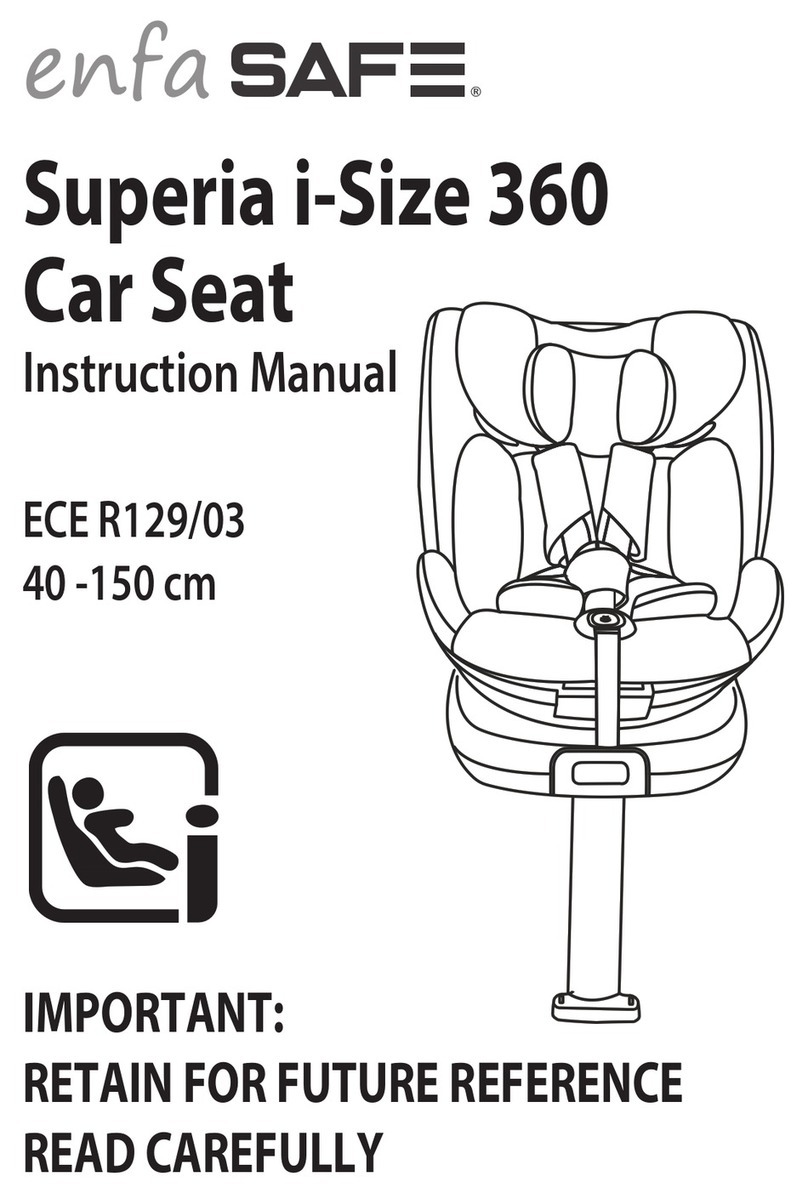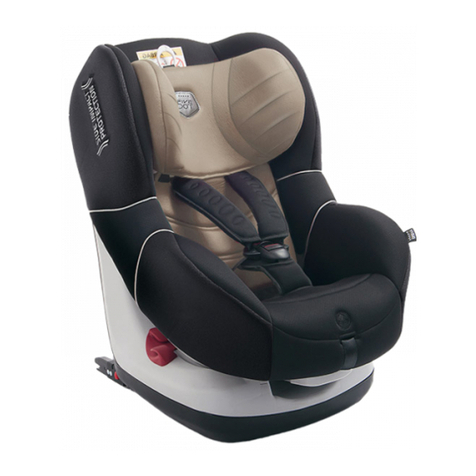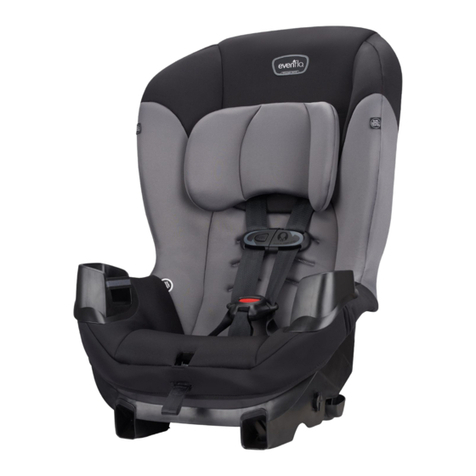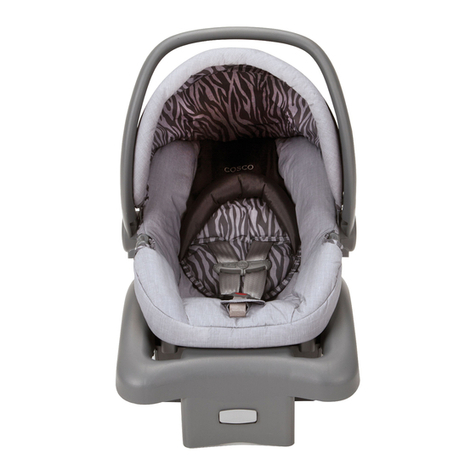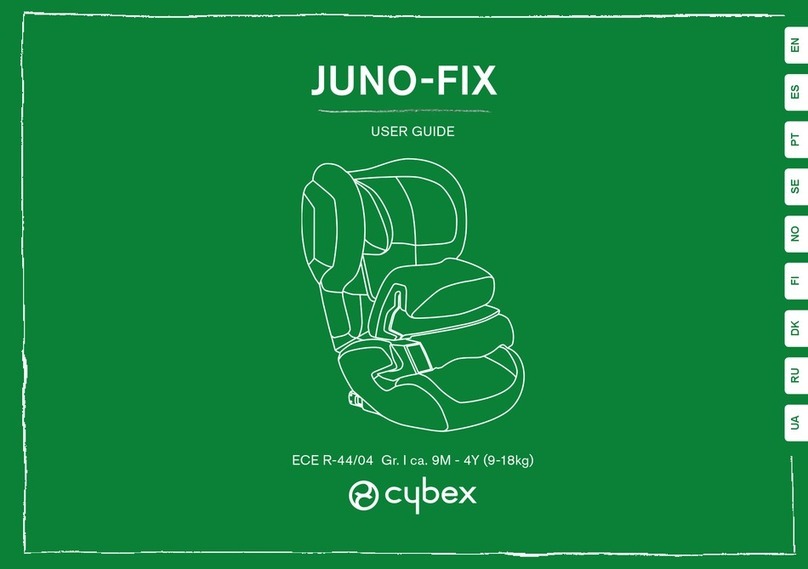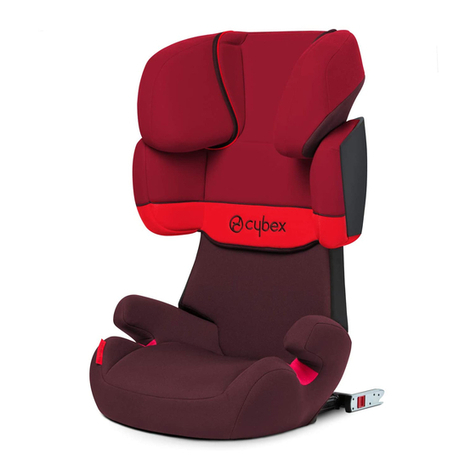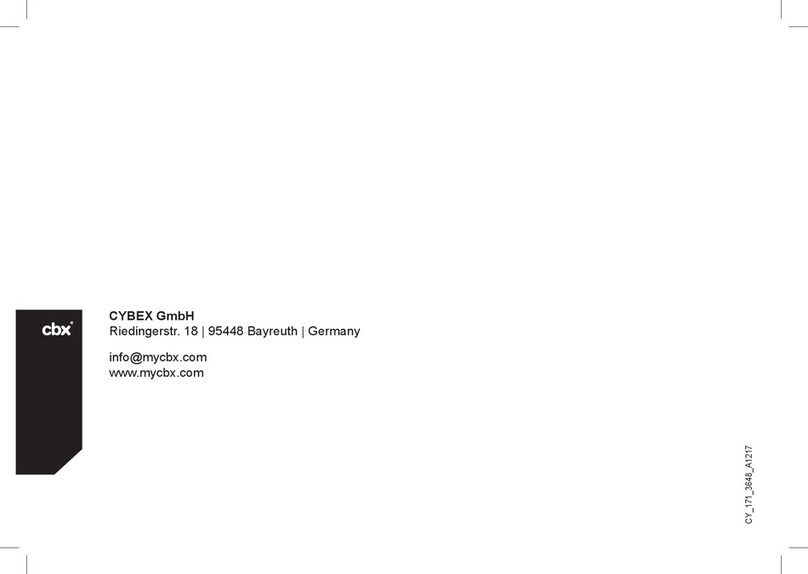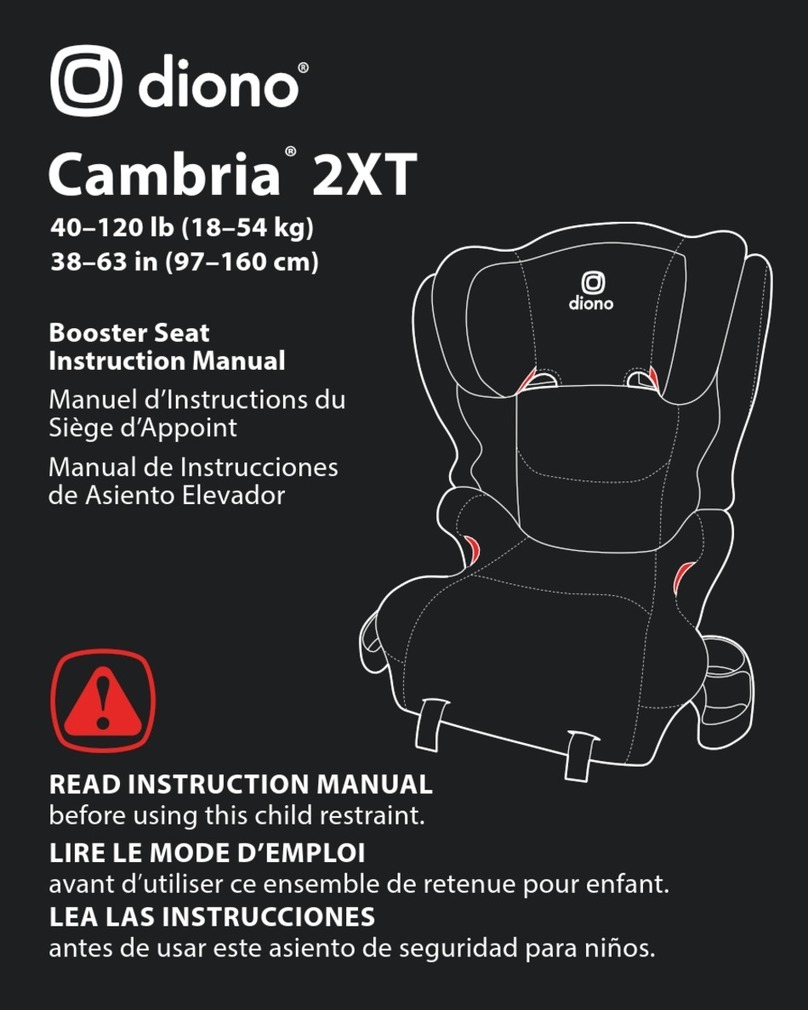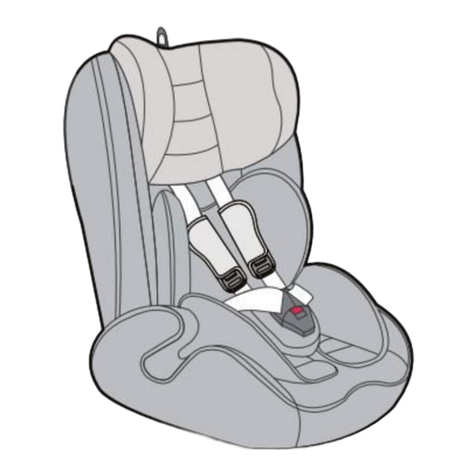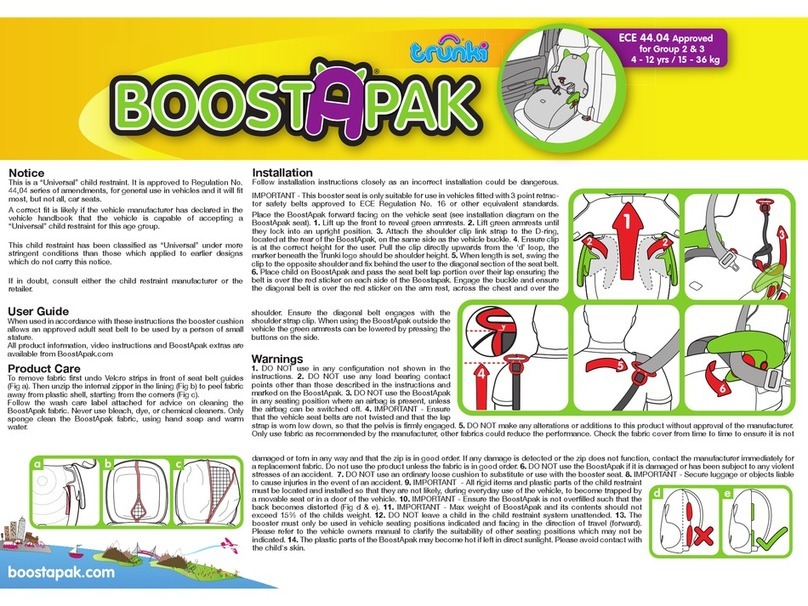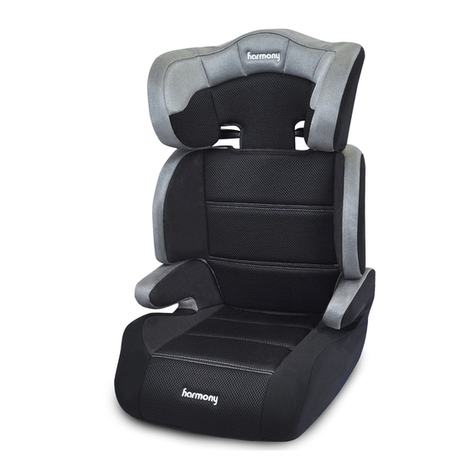EnfaSafe 360 ONE FOR ALL User manual

For further assistance with your EnfaSafe car seat,
please do not hesitate to call us on +353 1 2952111 or you can get in touch by email at [email protected]
EUROACTIVE HK LTD.
79/ 80 FURZE ROAD, SANDYFORD BUSINESS ESTATE, DUBLIN, D18 C5P9, IRELAND
INTERNATIONAL HOUSE, 12 CONSTANCE STREET, LONDON, E16 2DQ, UNITED KINGDOM
MADE IN CHINA
IMPORTANT: PLEASE KEEP
FOR FUTURE REFERENCE
READ CAREFULLY
Instruction Manual

CONTENTS
1. Notice
2. Parts labelled
3. Warning
4. Safety seat use method
4.1. Install location
4.2. How to use the harness buckle
4.3. Adjust the headrest
4.4. Adjusting the safety belt
4.5. To rotate the seat
4.6. To adjust the recline of the seat
4.7. Removing the 5-Point harness
and storing the parts
4.8. Adjusting the support leg
4.9. Removing the triangle pad and sleeping pad
4.10. Removing the fabric cover
5. Installed in the Car
5.1. Installed in the car with belt
5.1.1. Installed in rearward facing position with belt
5.1.1.1. Group 0+ (0-13kg)
12
IMPORTANT: READ THESE
INSTRUCTIONS CAREFULLY BEFORE
USE AND KEEP FOR FUTURE
REFERENCE
If these instructions are not followed, the
safety of a child may be severely endangered.
..............................................................................3
...................................................................5
...........................................................................6
...................................................8
...........................................................8
.................................9
.................................................10
..........................................12
....................................................13
..............................14
......................................................16
.........................................18
.........19
....................................19
........................................................20
....................................20
......20
............................................20
5.1.2. Installed in forward facing position with belt
5.1.2.1. Group I (9-18kg)
5.1.2.2. Group II III (15-36kg)
5.2. Installed in the car with ISOFIX connector
5.2.1. Installed in rearward facing position
with ISOFIX connector and support leg
Group 0 I (0-18kg)
5.2.2. Installed in forward facing position
with ISOFIX connector and support leg
Group I (9-18kg)
5.2.3. Installed in forward facing position with
ISOFIX connector and belt Group II III (15-36kg)
6. Care and Maintenance
7. Main Technical Parameter
.........21
................................................21
.........................................22
..............23
.........................................................23
............................................................24
...........25
..................................................26
............................................27

34
1. NOTICE
We recommend customer checks compatibility of the child restraint with the intended vehicle prior to fitting.
In rearward facing mode, never use the Child Restraint System in seating positions where an active frontal
airbag is installed. If in doubt, consult either the child restraint manufacturer or retailer.
When using as Universal category (Group II III),
please notice below information:
This is a “Universal” child restraint. It is
approved to Regulation No. 44, 04 series of
amendments, for general use in vehicles and
it will fit most, but not all car seats.
A correct fit is likely if the vehicle manufacturer
has declared in the vehicle handbook that the
vehicle is compatible with a “Universal” child
restraint for this age group.
This child restraint has been classified as
“Universal” under more stringent conditions
that those which applied to earlier designs
which do not carry this notice.
If in doubt, consult either the child restraint
manufacturer or the retailer.
Only suitable if the approved vehicles are fitted
with 3-point safety belts, approved according to
UN/ECE Regulation No.16 or other equivalent
standards.
CAR
.
(Model)
REAR
Centre
Yes No
FRONT
Outer
Yes
When using as Semi-Universal category
(Group 0+ I II III), please notice below information:
This child restraint is classified for "Semi-universal"
use and is suitable for fixing into the seat positions
of the following cars:
Only suitable if the approved vehicles are fitted with
3-point safety belts and ISOFIX attachments,
approved to UN/ECE Regulation No. 16 or other
equivalent standards.
Notice regarding ISOFIX child restraint system
(Group 0 I Rearward facing):
1. This is an ISOFIX CHILD RESTRAINT SYSTEM.
It is approved to the Regulation No. 44,04 series of
amendments, for general use in vehicles fitted with
ISOFIX anchorage systems.
2. It will fit vehicles with positions approved as
ISOFIX positions (as detailed in the vehicle
handbook), depending on the category of the child
seat and of the fixture.
3. The mass group and the ISOFIX size class for
which this device is intended is:
E for Group 0 (0-10kg) and D for Group I (9-18kg).
Notice regarding ISOFIX child restraint system
(Group I Forward facing):
1. This is an ISOFIX CHILD RESTRAINT SYSTEM.
It is approved to the Regulation No. 44,04 series of
amendments, for general use in vehicles fitted with
ISOFIX anchorage systems.
2. It will fit vehicles with positions approved as ISOFIX
positions (as detailed in the vehicle handbook),
depending on the category of the child seat and of
the fixture.
3. The mass group and the ISOFIX size class for
which this device is intended is:
E for Group 0 (0-10kg) and D for Group I (9-18kg).

56
2. PARTS LABELLED 3. WARNING
IMPORTANT: Please carefully read and
make sure sure you understand all instructions
in this manual and in the vehicle owner’s
manual related to child safety seats.
Install and use the child safety seat as
described in the instruction manual.
Failure to do this could result in serious
injury or death of your child. Keep the
instructions together with the child restraint
for future reference.
IMPORTANT: Because of potential medical
issues inherent to low birth weight and
premature infants, always have a trained
professional doctor or hospital staff member
assess the suitability of the child restraint prior
to leaving the hospital or using the child
restraint.
DO NOT use a child safety seat with damaged or
missing parts.
DO NOT use damaged or frayed harness straps
or vehicle belt.
NEVER use this child restraint with any other base
except ones that the manufacturer permits.
DO NOT use a child safety seat that has been in a
crash. A crash can cause damage to the child safety
seat that you cannot see.
DO NOT use a second-hand child seat or child seat
whose history you do not know.
DO NOT leave your child in this restraint for an
extended period of time.
DO NOT use on vehicle seats that face the sides or
rear of the vehicle. Use the child safety seat only on
forward-facing vehicle seats.
The rigid items and plastic parts of a child restraint
must be so located and installed that they are not
liable, during everyday use of the vehicle, to
become trapped by a movable seat or in a door of
the vehicle.
Keep the restraint rear-facing until the child's mass
is greater than 9kg.
Support Leg
ISOFIX
button
Adjust
button
Belt guidance
Gears fixed axle
ISOFIX
attachment
point
ISOFIX Locking Arms
ISOFIX insert guide
(If you don’t have ISOFIX
insert guide, please ignore this)
Instruction back
cover (can insert
instruction into it)
Belt guidance
Support leg display window
Shoulder belt
Buckle
Base
Belt guidance
Crotch belt
Seat cover
Shoulder pad
Buckle tongue
Red button
Crotch pad
Press button
Sleeping pad
Headrest
height adjuster
Headrest
Recline handle
360 Rotate adjuster

3. WARNING
Any straps holding the restraint to the vehicle
should be tight. Any straps restraining the child
should be adjusted to the child's body, and the
straps should not be twisted.
Ensure that any lap strap is worn low down, so
that the pelvis is firmly engaged, shall be stressed.
It is dangerous that making any alterations or
additions to the device without the approval of
the competent authority, and not following closely
the installation instructions provided by the child
restraint manufacturer.
The chair should be kept away from sunlight,
otherwise it may be too hot for the child's skin.
Do not leave a child unattended in the child
restraint system.
Any luggage or other objects liable to cause
injuries in the event of a collision shall be properly
secured.
78
4. SAFETY SEAT USE METHOD
4.1 INSTALL LOCATION:
4.1.1. When using as Universal category
(Group II III), this child restraint system is suitable
for seat belt models equipped with a 3-point
retractor that complies with ECE R16 and does
not apply to models only equipped with 2-point
seat belts.
4.1.2. When using as Semi-Universal category
(Group 0 0+ I II III), this child restraint system is
suitable for seat belt models equipped with the
3-point retractor that has passed the ECE R16
and ECE R14 requirement and is not suitable for
models only equipped with 2-point seat belts.
The child restraint must not be used without the
cover. The seat cover should not be replaced with
any other than the one recommended by the
manufacturer, because the cover constitutes an
integral part of the restraint performance.
If position of the adult safety-belt buckle relative to
the main load bearing contact points on the child
safety seat is unsatisfactory. Please contact the
manufacturer if in doubt about this point.
Not to use any load bearing contact points
other than those described in the instructions and
marked in the child restraint.
Please read the car manufacturer's handbook
before installing this ISOFIX child safety seat.
Car Safety Belt—Diagonal Belt
Car Safety Belt—Lap Belt
Car Safety Belt—Diagonal Belt
Car Safety Belt—Lap Belt
ISOFIX Attachments

910
4.3. ADJUST THE HEADREST:
A. When in Group 0 0+I (use level 1-6)
The shoulder straps are adjusted as follows:
Loosen the shoulder straps of the child seat as
much as possible.
Pull the headrest height adjuster, select the
correct height of the shoulder straps and
engage it in the position that fits your child by
releasing the adjuster.
4.2. HOW TO USE THE HARNESS BUCKLE:
Hold the two buckle tongues together.
Make sure the right side is up.
Engage them before putting them into the harness
buckle, which should hear an audible CLICK.
Pull shoulder straps to remove all slack from the lap
section ensuring that the harness is lying flat and
the harness buckle is locked.
Open the harness buckle by pressing the red
button.
Only with 3-point seat belt and ISOFIX
attachments, can install in this place.
Correct/ Proper Wrong/ Improper
Only if front airbag is deactivated,
can install in this place.

11 12
CAUTION! The shoulder straps must not run
behind the child’s back, at ear height or above
the ears.
4.4. ADJUSTING THE SAFETY BELT
A. To Tighten Safety Belt:
Pull up shoulder belt and the lap belt will tighten,
then pull crotch belt to tighten safety belt.
Tighten the safety belt as much as possible without
causing discomfort to the child. The lap belt should
be placed as low as possible and should be
positioned near child’s crotch not abdomen.
P.S: A loose safety belt is dangerous.
Please check safety belt adjuster whether work,
then tighten safety belt. After tightening the seat belt,
adjust the shoulder pads to the appropriate
position on the chest.
B. To Loosen Safety Belt:
When pressing the safety belt adjuster, the other
hand must grasp the safety belt which is under the
shoulder pads and pull it forward to release the
safety belt.
Keep the lower edge of headrest as close as possible
to the child's shoulder and keep a finger distance
between the lower edge of headrest and child’s
shoulder (see picture a).
4.3. ADJUST THE HEADREST:
B. When in Group II III (use level 7-10)
When child grows up above 15kg, the headrest
should be used at the 7-10 level height.
Slide the belt loops off from gear fixed axle, slide
the left shoulder belt first then to the right one, you
can remove the shoulder belt (see 4.7).
Then from the front of the child seat, pull the
shoulder straps out through the slots and put
them under the cloth cover.
After removing them, take out the gear fixed axle
from the plastic stator and store it.
Pull the headrest height adjuster, select the
correct height of the shoulder straps and engage
it in the position that fits your child by releasing
the adjuster.
ATTENTION! A correctly adjusted headrest
ensures optimal protection for your child in the
safety seat.
The headrest must be adjusted so that the
shoulder straps are at the same level as your
child’s shoulders.

13 14
4.6. TO ADJUST THE RECLINE OF THE SEAT
Push the recline handle up and pull the seat outward
(see picture a), then the seat can be adjusted.
It can be adjusted to 4 positions for forward facing
use (see p15 picture ).
When the seat is in the position of fourth level, rotate
the seat to the rearward direction, and the seat can
be adjusted to the fifth level (see p15 picture ).
Only suitable for Group 0 0+ I (0-18kg).
Different groups use different recline levels.
Group I (9-18kg): first level to fourth level
(see p15 picture ).
Group II III (15-36kg): first level (see p15 picture ).
4.5. TO ROTATE THE SEAT:
Pull the rotation adjuster out with your thumb,
then rotate the safety car seat to 360° angle.
(see picture a).
ACTION: Each time rebound the rotation
adjuster back. To make sure the seat is
fixed well.
A. Rearward direction: Group 0 0+1 (0-18kg),
must use rearward direction (see picture 1).
B. Forward direction: Group I II III (9-36kg),
must use forward direction (see picture 2).
a
picture 2 picture 1
a

15 16
4.7. REMOVING THE 5-POINT HARNESS AND
STORING THE PARTS
Step 1: Open the storage compartment at the rear
of the car seat.
Step 2: Remove the shoulder pads.
Step 3: Loosen the 5-point harness to
maximise extension.
Remove the harness from the
metal link area at the rear backrest
(Picture A and Picture B).
Remove the harness axle from the plastic housing
and place in storage area at the rear backrest
(Picture C).
Step 4: Close the storage compartment after placing
the harness connector and axle into the correct storage
areas. Store belt as shown under seat cover
(Picture D).
First Level Fifth Level (Lying Level)
Second Level
Third Level Fourth Level
5
5
5
C
D
A
Harness Connector
B

17 18
4.8. ADJUST THE SUPPORT LEG
Pull out the support leg to the maximum angle.
a. Press the adjust button of support leg, hold the
support leg using the other hand and then
adjust the length of support leg.
b. When the support leg is in full contact with the
ground of vehicle, release the adjust
button. Pull the support leg to make sure it is locked.
NOTE: c. After finishing the installation of support
leg, the display window turns green.
4.7. REMOVING THE 5-POINT HARNESS AND
STORING THE PARTS
Step 3: Storing the buckle:
Open the buckle, take out buckle tongues from
shoulder belt. Pull down buckle cross cloth cover.
Later pick up the cover in the PE board and store
the buckle (Picture E and F).
EF

19 20
5. INSTALLED IN THE CAR
5.1. INSTALLED IN THE CAR WITH BELT
5.1.1. Installed in rearward facing position with belt
5.1.1.1. Group 0+ (0-13kg)
Pull out the support leg, adjust it to the maximum
angle.
Press the adjust button of support leg, adjust the
length of the support leg so that it is in full contact
with the ground of the vehicle (display window
turns green).
Pull the vehicle seat belt and pass the lap belt
section through the belt guidance and under
the sleeping cushion.
Pass the diagonal seat belt section through the
belt guidance .
Fasten the seat belt and pull it tight, ensuring
that the seat belt is not twisted.
NOTE: For children of this size, the child seat
must only be installed in the rearward facing
position and at a maximum angle of inclination
(lying level). To make sure that the car seat has
been installed correctly, please check it carefully
before use.
4.9. REMOVING TRIANGLE PAD AND
SLEEPING PAD
When your child’s weight exceeds 8kg, remove the
triangle pad.
When your child’s weight exceeds 12kg, remove the
sleeping pad.
4.10. REMOVING THE FABRIC COVER
1. Remove the 5-point harness.
2. Take off the cover from the backrest and base.
3. Move the headrest of the child seat up to the
highest position.
4. First take the cover off the base of the
headrest, then remove the cover of the
headrest.
To re-fit the cover, simply follow the above steps
in reverse.
CAUTION! Never use the child seat without a
correctly installed buckle.
CAUTION! Check that the harness straps are not
twisted and that they have been correctly
inserted in the belt slots of the cover.
DO NOT twist the belt!
Ensure that the buckle tongues are properly
locked into the vehicle seat buckle - you will
hear an audible CLICK!
Green
Green

21 22
5.1. INSTALLED IN THE CAR WITH BELT
5.1.2.2. Group II III (15-36kg)
NOTE: When you use this safety car seat in
Group II III, please remove the 5-point harness,
sleeping pads and the triangle pads (refer to 4.7.).
Place the child seat forward facing on
the vehicle seat (in the direction of travel).
Press the adjust button of support leg, adjust the
support leg upwards to the shortest, make it hang.
Ensure that the support leg shows red indicator.
First pull out the belt from the belt ALR. Diagonal
belt through the same side of Guidance , lap belt
through the same side of Guidance , then pull the
diagonal belt and lap belt together through another
side of Guidance .
NOTE: Keep the diagonal belt at the position
of shoulder between the outside of the neck
and shoulder (middle of point A and B )
(see picture a).
Lock the tip of the buckle into the vehicle
seat buckle with a CLICK noise. Follow the
direction of arrow to tighten belt, and put
redundant belt into cloth cover. Check the child
safety car seat to make sure it is securely
attached.
5.1. INSTALLED IN THE CAR WITH BELT
5.1.2. Installed in forward facing position with belt
5.1.2.1. Group 1 (9-18kg)
Place the child seat forward facing on the vehicle
seat (in the direction of travel).
Pull out the support leg, adjust it to the
maximum angle.
Press the adjust button of support leg, adjust the
length of the support leg so that it is in full contact
with the ground of the vehicle (display window
turns green).
Pull the diagonal belt section through belt
guidance .Place the lap belt section in the
belt guidance .
Pull out safety belt from the back to the side, lap
belt section respectively from the belt guidance
of the base. One side of the diagonal belt through
the backrest and the belt guidance ,another side
along the upper inside.
Using your knee to press down on the child seat,
tighten the vehicle seat belt as follows:
Pull on the lower part of the diagonal seat belt
section near the vehicle seat buckle to tighten the
lap belt section.
CAUTION! The diagonal seat belt section must run
diagonally backward. You can adjust the course of
the belt with your vehicle's adjustable belt deflector
on both sides.
Ensure the lap
belt is as close as
possible to lower.
Ensure the lap
belt is on the
pelvis, not on the
abdomen.
CLICK
a
A
B

23 24
5.2. INSTALLED IN THE CAR WITH ISOFIX CONNECTOR
5.2.2. Installed in forward facing position with ISOFIX
connector and support leg; Group I (9-18kg).
Put the ISOFIX insert guide into the two ISOFIX
attachment points of your vehicle.
If you don’t have the ISOFIX insert guide, please ignore
this step.
NOTE: The ISOFIX attachment points are located
between the surface and the backrest of the vehicle
seat.
Press the ISOFIX button to pull out the two locking
arms from the base bottom. Pull the locking arm
to and fro until you hear an audible CLICK which
indicates they are fully engaged. Both sides of the
locking arms’ button turn green.
Pull out the support leg, adjust it to the maximum
angle.
Press the adjust button of support leg, adjust the length
of the support leg so that it is in full contact with the
ground of the vehicle (display window turns green).
5.2. INSTALLED IN THE CAR WITH ISOFIX CONNECTOR
5.2.1. Installed in rearward facing position with ISOFIX
connector and support leg; Group 0 1 (0-18kg).
Put the ISOFIX insert guide into the two ISOFIX
attachment points of your vehicle.
If you don’t have the ISOFIX insert guide, please
ignore this step.
NOTE: The ISOFIX attachment points are located
between the surface and the backrest of the vehicle
seat.
Press the ISOFIX button to pull out the two locking
arms from the base bottom. Pull the locking arm to and
fro until you hear an audible CLICK which indicates they
are fully engaged. Both sides of the locking
arms’ button turn green.
Pull out the support leg, adjust it to the maximum
angle.
Press the adjust button of support leg, adjust the length
of the support leg so that it is in full contact with the
ground of the vehicle (display window turns green).
CLICK
CLICK

25 26
CAUTION! The diagonal seat belt section must
run diagonally backward. You can adjust the
course of the belt with your vehicle’s adjustable
belt deflector on both sides.
5.2. INSTALLED IN THE CAR WITH ISOFIX CONNECTOR
5.2.3. Installed in forward facing position with ISOFIX
connector and belt; Group II III (15-36kg).
NOTE: When you use this safety car seat in
Group II III please remove the 5-point harness,
sleeping pads and the triangle pads (refer to 4.7.)
Place the child seat forward facing on the vehicle
seat (in the direction of travel).
Put the ISOFIX insert guide into the two ISOFIX
attachment points of your vehicle.
If you don’t have the ISOFIX insert guide, please
ignore this step.
NOTE: The ISOFIX attachment points are located
between the surface and the backrest of the vehicle
seat.
Press the ISOFIX button to pull out the two locking
arms from the base bottom. Pull the locking arm to
and fro until you hear an audible CLICK which
indicates they are fully engaged. Both sides of the
locking arms’ button turn green.
Press the adjust button of support leg, adjust the
support leg upwards to the shortest, allowing it
to hang.
Ensure that the support leg shows red indicator.
First pull out the belt from the belt ALR. Diagonal
belt through the same side of Guidance , lap belt
through the same side of Guidance, then pull the
diagonal belt and lap belt together through another
side of Guidance .
NOTE: Keep the diagonal belt at the position of
shoulder between the outside of the neck and
shoulder (middle of point A and B )
(see p25 picture a)
Lock the tip of the buckle into the vehicle seat
buckle when hear an audible CLICK. Follow the
direction of arrow to tighten belt, and put
redundant belt into cloth cover. Check the child
safety car seat to make sure it is securely
attached.
6. CARE AND MAINTENANCE
Periodically inspect your child seat for worn or
damaged parts. If damaged parts are found,
replace the child seat. Keep the child seat clean.
Do not lubricate any parts of the child seat.
To prolong the life of your car seat, keep it
clean and do not leave it in direct sunlight for
extended periods of time.
Removable fabric covers and trims may be cleaned
using warm water with a household soap or a mild
detergent. Allow it to dry fully, preferably away from
direct sunlight.
CLEANING THE BUCKLE:
Food, drink, or other debris may collect inside the
harness buckle which can affect proper functioning.
Wash in warm water until clean. Be sure you can
hear an audible CLICK to make sure the buckle is
working properly.
Ensure the lap
belt is as close as
possible to lower.
Ensure the lap
belt is on the
pelvis, not on the
abdomen.
a
A
B

27 28
6. CARE AND MAINTENANCE
CLEANING THE HARNESS AND SHELL:
Sponge clean using warm water and mild soap;
do not use any other cleaning agents.
STORAGE:
Store in a safe, dry place and away from heat
and direct sunlight.
Avoid placing heavy objects on top of the seat.
7. MAIN TECHNICAL PARAMETER
Length: 510mm
Width: 436mm
Height: 640-840mm
436mm 510mm
640-840mm
HAND WASH ONLY
TEMPERATURE 30°C
DO NOT BLEACH
DO NOT DRY
CLEAN
DO NOT TUMBLE DRY
DO NOT IRON
DRY FLAT IN THE SHADE
Table of contents
Other EnfaSafe Car Seat manuals

